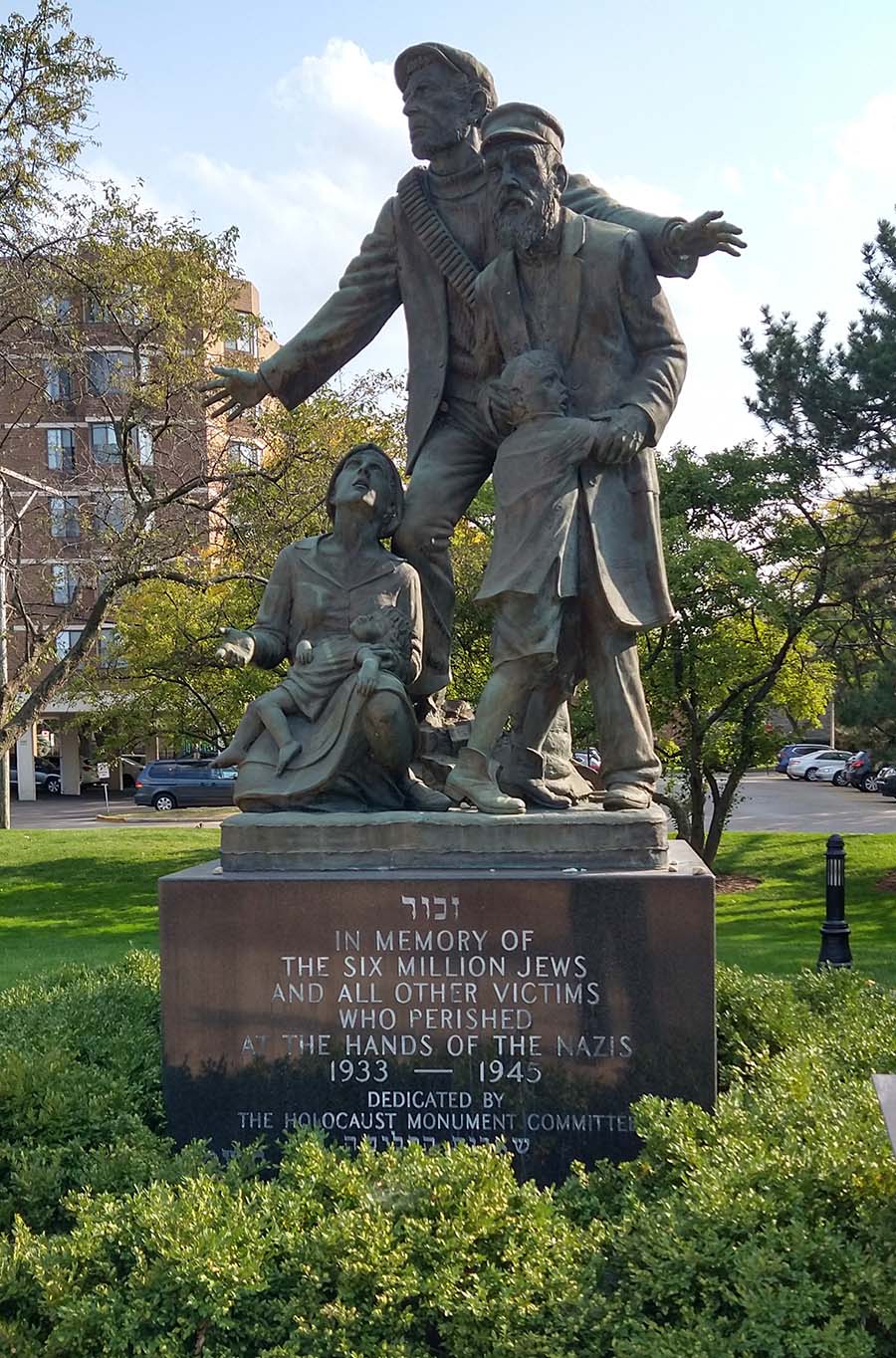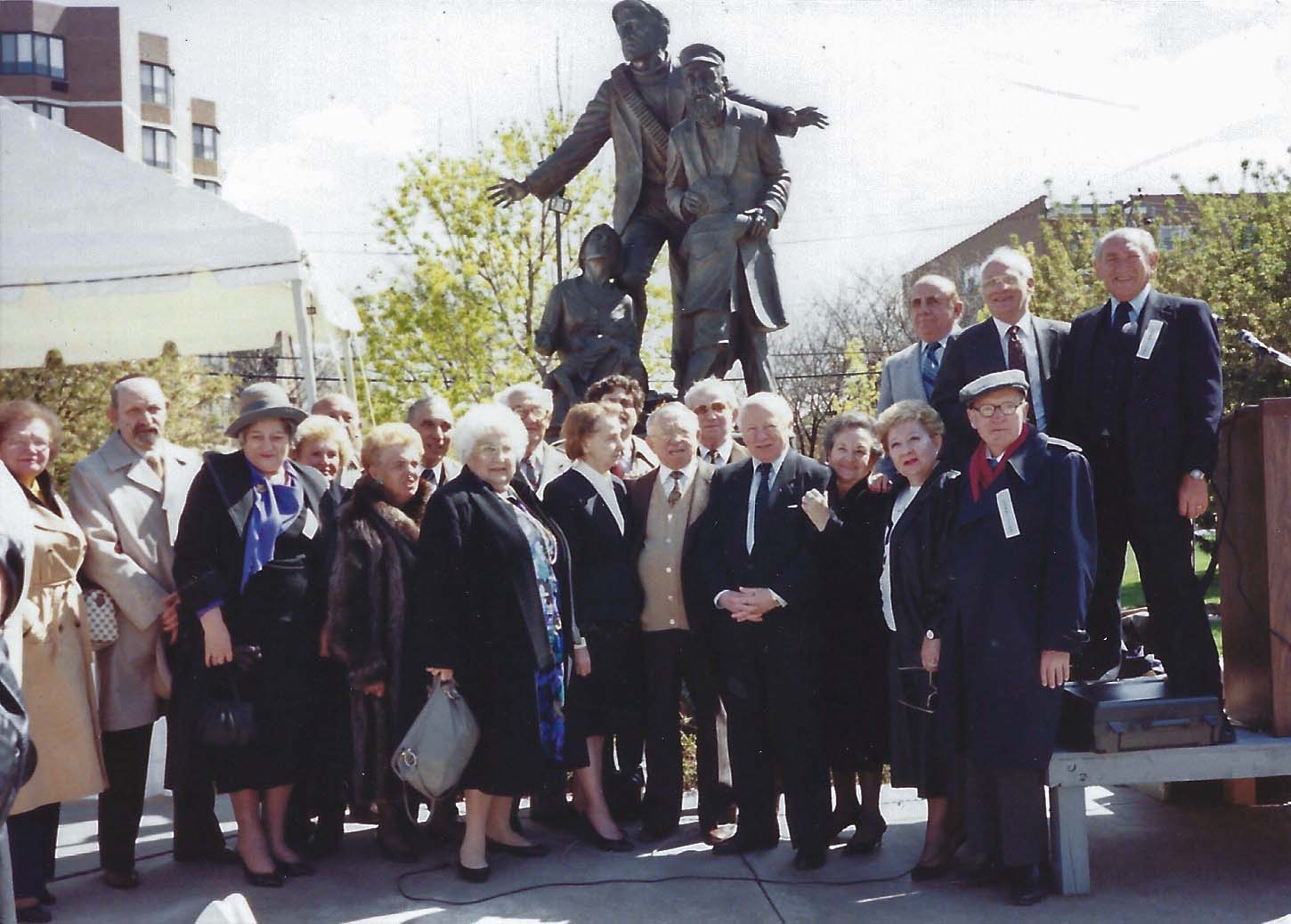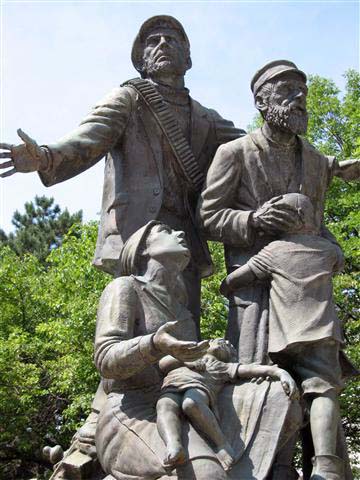Creation of Skokie Monument
It was in the summers of 1978 and 1981 when a neo-Nazi group desired to hold a demonstration, to march through the main street, in the Village of Skokie.
Skokie was chosen as the location because it was the home of 7,000 Holocaust survivors, more than in any other suburb of Chicago, including the city proper. But in Skokie, the neo-Nazis met with an unexpected resistance. The newcomers (Holocaust survivors) in Skokie were organized and determined not to let it (referring to the persecution of the Holocaust) happen again. Also, the non-Jewish population of the Village, with its determined Mayor Albert J. Smith and Village Board of Trustees, were squarely behind the Holocaust survivors. After numerous court battles and a major counter demonstration by the survivors, the march was called off.
This dramatic event so inspired the outside world that a television version of the event, with Danny Kaye in the main role, was aired for the whole world to see, proving that with determination and the support of the people, hate and racism can be overcome. This realization also galvanized the Sheerith Hapleitah, or so-called Holocaust survivors, and they began to think about erecting a monument for the six million Jews and other victims of Nazism.
It was agreed that a permanent committee should be established to work for the realization of this project. Mr. Abram Swajger and Mr. Charles Lipshitz were put in charge of the project. Mr. Meyer Rubinstein and Mrs. Barbara Pryor were elected Vice-Presidents; Mrs. Tunia Kogan, Corresponding Secretary and Mr. William Mishell and Mr. Leo Sheiderman, Editors. An advisory committee, including Financial Secretary Joseph Birnberg, was also appointed.
Furious activity then began. The first problem to be resolved was the location of the monument. Several choices were proposed, but none were satisfactory. Upon the suggestion of the committee, Mayor Albert J. Smith and Village officials were approached with the idea of using Village property for the purpose of placing a Holocaust monument in memory of all the victims who perished at the hands of the Nazis.
With the location now approved, the next problem was to select an artist to design the monument. Numerous proposals were presented to the Holocaust Monument Committee and, finally, the design of Bert Gast of Chicago was selected. Edward Chesney of Detroit was the proposed sculptor and
Fred Komick was given the assignment of general contractor. The design was presented to Mayor Smith and Village Trustees who reviewed every detail and made a few additional improvements.
The next step was to select the appropriate inscriptions for all four sides of the base of the monument. Every word and sentence was agonized over and it took over 10 meetings to come up with the final text. Rabbis and experts were consulted and their opinions seriously weighed. In the final analysis, six names of extermination camps, one for every million victims, were approved and a saying from the book of Lamentations, both in its original Hebrew from and an English translation, were selected by the Committee and approved by the Village.
Now the last problem had to be faced- that of collecting the funds for the realization of this grandiose project. This task took the entire committee over two years to accomplish. The Presidents of the eight participating organizations approached their groups and urged maximum participation in this project. Synagogues, temples, banks, the J.U.F. and many local businessmen were approached and many of them responded generously. Finally, the necessary funds were received and the actual work began. The text was carved in the base in Vermont and the sculpture modeled in Detroit.
In its final shape the sculpture depicts a freedom fighter, a grandfather, a scared, young boy and a mother with a dead child in her arms. All of them are standing on debris of bricks, tom prayer books, a menorah and other items, all of which symbolize the destruction of European Jewry. The figures are larger than life size, about nine feet tall, standing on a five foot granite base perfectly engraved and polished. The individual pieces were loaded on trucks and shipped to the site in Skokie, where they were assembled right next to the library.
The ground-breaking ceremony took place April 6, 1986 and on May 31, 1987 a dignified and memorable unveiling ceremony was conducted under the Chairmanship of Mr. Charles Lipshitz and committee members. The dedication was attended by over 3,000 people including dignitaries, senators, congressmen, judges, clergy and rabbis. Mayor Albert J. Smith and the Village Trustees were also in attendance and deserve particular credit for this project. In the name of the second generation, an acceptance legacy was read by Dr. Joseph Mishell and Ms. Sherry Rubinstein, both children of Holocaust survivors. A memorial service was chanted by cantor Abe Mendelsberg and when the statue was unveiled the assembly burst into loud applause.
All afternoon and late into the evening hundreds of people were coming and going to view the impressive piece of art on the Village Green in Skokie.
When night fell over Skokie, the crowds dispersed and the underworld crawled out from their holes and got ready to commit their dastardly deed. When Skokie awoke on the morning of June 1st, the entire monument was sprayed with paint depicting swastikas and slogans like “Jew liars” and other contemptuous epithets. Thousands of people gathered at the monument in total disbelief at the monstrous deed committed by vandals. Mayor Smith expressed his anger and outrage to the media.
Members of the press came to view the defaced monument and detailed reports were sent to newspapers and television stations all over the country. That evening, rabbis led a large audience in prayer and on June 2nd, an ecumenical service was held in front of the monument.
Today, the monument is an international attraction and people from all over the world come to Skokie to view the exquisite creation. Daily, at the foot of the monument, flowers can be seen, placed by anonymous donors, both non-Jewish and Jewish, as a symbol of identification with the victims. This monument will remain in perpetuity as a reminder of what hate can do to mankind if decent people are not vigilant to forestall such a calamity in the future.



